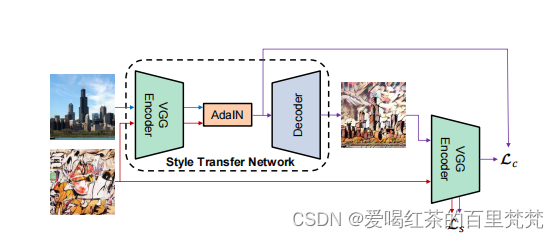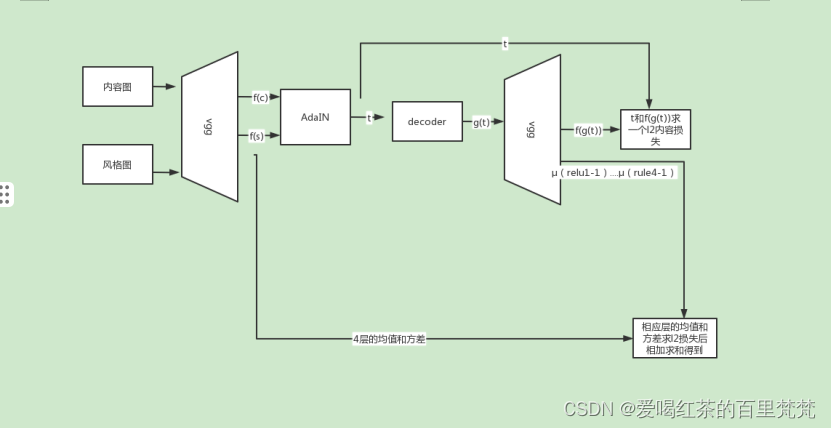AdaIN任意风格迁移代码分析
按照论文的结构,将代码分为三个部分
一、编码器
二、融合模块
三、解码器
四、训练
五、测试
一、编码器在这里插入图片描述
1、使用预训练模型vgg作为编码器
vgg = nn.Sequential(
nn.Conv2d(3, 3, (1, 1)),
nn.ReflectionPad2d((1, 1, 1, 1)),
nn.Conv2d(3, 64, (3, 3)),
nn.ReLU(), # relu1-1
nn.ReflectionPad2d((1, 1, 1, 1)),
nn.Conv2d(64, 64, (3, 3)),
nn.ReLU(), # relu1-2
nn.MaxPool2d((2, 2), (2, 2), (0, 0), ceil_mode=True),
nn.ReflectionPad2d((1, 1, 1, 1)),
nn.Conv2d(64, 128, (3, 3)),
nn.ReLU(), # relu2-1
nn.ReflectionPad2d((1, 1, 1, 1)),
nn.Conv2d(128, 128, (3, 3)),
nn.ReLU(), # relu2-2
nn.MaxPool2d((2, 2), (2, 2), (0, 0), ceil_mode=True),
nn.ReflectionPad2d((1, 1, 1, 1)),
nn.Conv2d(128, 256, (3, 3)),
nn.ReLU(), # relu3-1
nn.ReflectionPad2d((1, 1, 1, 1)),
nn.Conv2d(256, 256, (3, 3)),
nn.ReLU(), # relu3-2
nn.ReflectionPad2d((1, 1, 1, 1)),
nn.Conv2d(256, 256, (3, 3)),
nn.ReLU(), # relu3-3
nn.ReflectionPad2d((1, 1, 1, 1)),
nn.Conv2d(256, 256, (3, 3)),
nn.ReLU(), # relu3-4
nn.MaxPool2d((2, 2), (2, 2), (0, 0), ceil_mode=True),
nn.ReflectionPad2d((1, 1, 1, 1)),
nn.Conv2d(256, 512, (3, 3)),
nn.ReLU(), # relu4-1, this is the last layer used
nn.ReflectionPad2d((1, 1, 1, 1)),
nn.Conv2d(512, 512, (3, 3)),
nn.ReLU(), # relu4-2
nn.ReflectionPad2d((1, 1, 1, 1)),
nn.Conv2d(512, 512, (3, 3)),
nn.ReLU(), # relu4-3
nn.ReflectionPad2d((1, 1, 1, 1)),
nn.Conv2d(512, 512, (3, 3)),
nn.ReLU(), # relu4-4
nn.MaxPool2d((2, 2), (2, 2), (0, 0), ceil_mode=True),
nn.ReflectionPad2d((1, 1, 1, 1)),
nn.Conv2d(512, 512, (3, 3)),
nn.ReLU(), # relu5-1
nn.ReflectionPad2d((1, 1, 1, 1)),
nn.Conv2d(512, 512, (3, 3)),
nn.ReLU(), # relu5-2
nn.ReflectionPad2d((1, 1, 1, 1)),
nn.Conv2d(512, 512, (3, 3)),
nn.ReLU(), # relu5-3
nn.ReflectionPad2d((1, 1, 1, 1)),
nn.Conv2d(512, 512, (3, 3)),
nn.ReLU() # relu5-4
)
2、修改vgg网络,选取前三十一层作为编码器
def __init__(self, encoder, decoder):
super(Net, self).__init__()
enc_layers = list(encoder.children())
self.enc_1 = nn.Sequential(*enc_layers[:4]) # input -> relu1_1
self.enc_2 = nn.Sequential(*enc_layers[4:11]) # relu1_1 -> relu2_1
self.enc_3 = nn.Sequential(*enc_layers[11:18]) # relu2_1 -> relu3_1
self.enc_4 = nn.Sequential(*enc_layers[18:31]) # relu3_1 -> relu4_1
self.decoder = decoder
self.mse_loss = nn.MSELoss()
# fix the encoder
for name in ['enc_1', 'enc_2', 'enc_3', 'enc_4']:
for param in getattr(self, name).parameters():
param.requires_grad = False
# extract relu1_1, relu2_1, relu3_1, relu4_1 from input image
3、网络的总体结构
# 已分析
class Net(nn.Module):
def __init__(self, encoder, decoder):
super(Net, self).__init__()
enc_layers = list(encoder.children())
self.enc_1 = nn.Sequential(*enc_layers[:4]) # input -> relu1_1
self.enc_2 = nn.Sequential(*enc_layers[4:11]) # relu1_1 -> relu2_1
self.enc_3 = nn.Sequential(*enc_layers[11:18]) # relu2_1 -> relu3_1
self.enc_4 = nn.Sequential(*enc_layers[18:31]) # relu3_1 -> relu4_1
self.decoder = decoder
self.mse_loss = nn.MSELoss()
# fix the encoder
for name in ['enc_1', 'enc_2', 'enc_3', 'enc_4']:
for param in getattr(self, name).parameters():
param.requires_grad = False
# extract relu1_1, relu2_1, relu3_1, relu4_1 from input image
def encode_with_intermediate(self, input):
results = [input]
for i in range(4):
func = getattr(self, 'enc_{:d}'.format(i + 1))
results.append(func(results[-1]))
return results[1:]
# extract relu4_1 from input image
def encode(self, input):
for i in range(4):
input = getattr(self, 'enc_{:d}'.format(i + 1))(input)
return input
def calc_content_loss(self, input, target):
assert (input.size() == target.size())
assert (target.requires_grad is False)
return self.mse_loss(input, target)
def calc_style_loss(self, input, target):
assert (input.size() == target.size())
assert (target.requires_grad is False)
input_mean, input_std = calc_mean_std(input)
target_mean, target_std = calc_mean_std(target)
return self.mse_loss(input_mean, target_mean) + \
self.mse_loss(input_std, target_std)
def forward(self, content, style, alpha=1.0):
assert 0 <= alpha <= 1
style_feats = self.encode_with_intermediate(style)
content_feat = self.encode(content)
t = adain(content_feat, style_feats[-1])
t = alpha * t + (1 - alpha) * content_feat
g_t = self.decoder(t)
g_t_feats = self.encode_with_intermediate(g_t)
loss_c = self.calc_content_loss(g_t_feats[-1], t)
loss_s = self.calc_style_loss(g_t_feats[0], style_feats[0])
for i in range(1, 4):
loss_s += self.calc_style_loss(g_t_feats[i], style_feats[i])
return loss_c, loss_s
model = Net(vgg,decoder)
# 打印网络结构
print(model)
自己打印一下网络的结构
model = Net(vgg,decoder)
# 打印网络结构
print(model)
其网络结构输出如图所示:

二、融合模块
1、计算特征图的均值和标准差
def calc_mean_std(feat, eps=1e-5):
# eps是一个小值,用于避免方差为零时的除以零错误。
size = feat.size()
assert (len(size) == 4)
N, C = size[:2]
# 将特征图转换为形状为[N, C, H, W]的张量,并计算每个通道的方差
feat_var = feat.view(N, C, -1).var(dim=2) + eps
# 计算每个通道的标准差,并将形状转换为[N, C, 1, 1]
feat_std = feat_var.sqrt().view(N, C, 1, 1)
# 计算每个通道的均值,并将形状转换为[N, C, 1, 1]
feat_mean = feat.view(N, C, -1).mean(dim=2).view(N, C, 1, 1)
# 返回特征的均值和标准差
return feat_mean, feat_std
(1)解释函数:feat_var=feat.view()rashape的操作
举个例子:例如一个张量(2,3,4,4)
feat_var=feat.view(N,C,-1)→(2,3,16).var(dim)→(2,3)
例如:
feat =
tensor([[[ 1, 2, 3, 4, 5, 6, 7, 8, 9, 10, 11, 12, 13, 14, 15, 16],
[ 2, 4, 6, 8, 10, 12, 14, 16, 18, 20, 22, 24, 26, 28, 30, 32],
[ 3, 6, 9, 12, 15, 18, 21, 24, 27, 30, 33, 36, 39, 42, 45, 48]],
[[ 4, 8, 12, 16, 20, 24, 28, 32, 36, 40, 44, 48, 52, 56, 60, 64],
[ 5, 10, 15, 20, 25, 30, 35, 40, 45, 50, 55, 60, 65, 70, 75, 80],
[ 6, 12, 18, 24, 30, 36, 42, 48, 54, 60, 66, 72, 78, 84, 90, 96]]])
feat_viewed = feat.view(2, 3, 16) =
tensor([[[ 1, 2, 3, 4, 5, 6, 7, 8, 9, 10, 11, 12, 13, 14, 15, 16],
[ 2, 4, 6, 8, 10, 12, 14, 16, 18, 20, 22, 24, 26, 28, 30, 32],
[ 3, 6, 9, 12, 15, 18, 21, 24, 27, 30, 33, 36, 39, 42, 45, 48]],
[[ 4, 8, 12, 16, 20, 24, 28, 32, 36, 40, 44, 48, 52, 56, 60, 64],
[ 5, 10, 15, 20, 25, 30, 35, 40, 45, 50, 55, 60, 65, 70, 75, 80],
[ 6, 12, 18, 24, 30, 36, 42, 48, 54, 60, 66, 72, 78, 84, 90, 96]]])
feat_var[0] = feat_viewed[0].var(dim=1) =
tensor([ 22.9167, 170.6667, 340.6667])
feat_var[1] = feat_viewed[1].var(dim=1) =
tensor([ 230.6667, 850.0000, 1360.6667])
feat_var =
tensor([[ 22.9167, 170.6667, 340.6667],
[ 230.6667, 850.0000, 1360.6667]])
(2)解释函数feat_std = feat_var.sqrt().view(N, C, 1, 1)
#开方
feat_std = feat_var.sqrt() =
tensor([[ 4.7917, 13.0535, 18.4506],
[ 15.1905, 29.1548, 36.9193]])
#reshape
feat_std = feat_std.view(2, 3, 1, 1) =
tensor([[[[ 4.7917]],
[[ 13.0535]],
[[ 18.4506]]],
[[[ 15.1905]],
[[ 29.1548]],
[[ 36.9193]]]])
(3)解释 feat_mean = feat.view(N, C, -1).mean(dim=2).view(N, C, 1, 1)
feat =
tensor([[ 8.5000, 18.5000, 28.5000],
[ 36.5000, 46.5000, 56.5000]])
feat =
tensor([[[[ 8.5000]],
[[ 18.5000]],
[[ 28.5000]]],
[[[ 36.5000]],
[[ 46.5000]],
[[ 56.5000]]]])
2、归一化的处理
这个就是重点了,这几行代码可以说是论文的创新点了
def adaptive_instance_normalization(content_feat, style_feat):
assert (content_feat.size()[:2] == style_feat.size()[:2])
size = content_feat.size()
style_mean, style_std = calc_mean_std(style_feat)
content_mean, content_std = calc_mean_std(content_feat)
normalized_feat = (content_feat - content_mean.expand(
size)) / content_std.expand(size)
return normalized_feat * style_std.expand(size) + style_mean.expand(size)
需要解释的是.expand(size)
content_feat = torch.tensor([[1, 2], [3, 4]])
content_mean = torch.tensor([10])
size = content_feat.size()
#过程如下:[2,2],和一个[1]
[[10,10],[10,10]]
三、解码器
对此网络的训练主要是训练一个解码器
1、解码器
decoder = nn.Sequential(
nn.ReflectionPad2d((1, 1, 1, 1)),
nn.Conv2d(512, 256, (3, 3)),
nn.ReLU(),
nn.Upsample(scale_factor=2, mode='nearest'),
nn.ReflectionPad2d((1, 1, 1, 1)),
nn.Conv2d(256, 256, (3, 3)),
nn.ReLU(),
nn.ReflectionPad2d((1, 1, 1, 1)),
nn.Conv2d(256, 256, (3, 3)),
nn.ReLU(),
nn.ReflectionPad2d((1, 1, 1, 1)),
nn.Conv2d(256, 256, (3, 3)),
nn.ReLU(),
nn.ReflectionPad2d((1, 1, 1, 1)),
nn.Conv2d(256, 128, (3, 3)),
nn.ReLU(),
nn.Upsample(scale_factor=2, mode='nearest'),
nn.ReflectionPad2d((1, 1, 1, 1)),
nn.Conv2d(128, 128, (3, 3)),
nn.ReLU(),
nn.ReflectionPad2d((1, 1, 1, 1)),
nn.Conv2d(128, 64, (3, 3)),
nn.ReLU(),
nn.Upsample(scale_factor=2, mode='nearest'),
nn.ReflectionPad2d((1, 1, 1, 1)),
nn.Conv2d(64, 64, (3, 3)),
nn.ReLU(),
nn.ReflectionPad2d((1, 1, 1, 1)),
nn.Conv2d(64, 3, (3, 3)),
)
2、内容损失函数
计算一个l2的损失,均方误差
def calc_content_loss(self, input, target):
assert (input.size() == target.size())
assert (target.requires_grad is False)
return self.mse_loss(input, target)
3、风格损失函数
计算均值和方差的l2的损失
def calc_style_loss(self, input, target):
assert (input.size() == target.size())
assert (target.requires_grad is False)
input_mean, input_std = calc_mean_std(input)
target_mean, target_std = calc_mean_std(target)
return self.mse_loss(input_mean, target_mean) + \
self.mse_loss(input_std, target_std)
4、前向传播的过程
def forward(self, content, style, alpha=1.0):
assert 0 <= alpha <= 1
style_feats = self.encode_with_intermediate(style)
content_feat = self.encode(content)
t = adain(content_feat, style_feats[-1])
t = alpha * t + (1 - alpha) * content_feat
g_t = self.decoder(t)
g_t_feats = self.encode_with_intermediate(g_t)
loss_c = self.calc_content_loss(g_t_feats[-1], t)
loss_s = self.calc_style_loss(g_t_feats[0], style_feats[0])
for i in range(1, 4):
loss_s += self.calc_style_loss(g_t_feats[i], style_feats[i])
return loss_c, loss_s
四、训练
训练的是一个解码器所以并没有风格迁移模块的存在。
1、对数据的处理
def train_transform():
transform_list = [
transforms.Resize(size=(512, 512)),
transforms.RandomCrop(256),
#随机裁剪图像为256x256像素
transforms.ToTensor()
]
return transforms.Compose(transform_list)
class FlatFolderDataset(data.Dataset):
def __init__(self, root, transform):
super(FlatFolderDataset, self).__init__() # 调用父类的构造函数
self.root = root # 图像文件夹的路径
self.paths = list(Path(self.root).glob('*')) # 获取图像文件夹下所有图像文件的路径
self.transform = transform # 图像预处理的操作对象
def __getitem__(self, index):
path = self.paths[index] # 获取给定索引对应的图像文件路径
img = Image.open(str(path)).convert('RGB') # 使用 PIL.Image.open 打开图像文件,并转换为 RGB 格式
img = self.transform(img) # 对图像进行预处理操作
return img
def __len__(self):
return len(self.paths) # 返回数据集中图像的总数
def name(self):
return 'FlatFolderDataset' # 返回数据集类的名称
无限循环便利采样器
def InfiniteSampler(n):
# i = 0
i = n - 1
order = np.random.permutation(n)
while True:
yield order[i]
i += 1
if i >= n:
np.random.seed()
order = np.random.permutation(n)
i = 0
class InfiniteSamplerWrapper(data.sampler.Sampler):
def __init__(self, data_source):
self.num_samples = len(data_source)
def __iter__(self):
return iter(InfiniteSampler(self.num_samples))
def __len__(self):
return 2 ** 31
2、自动优化学习率
def adjust_learning_rate(optimizer, iteration_count):
# 计算学习率,使用原始实现的公式
lr = args.lr / (1.0 + args.lr_decay * iteration_count)
# 遍历优化器中的每个参数组
for param_group in optimizer.param_groups:
# 更新参数组的学习率为新计算的学习率值
param_group['lr'] = lr
3、基础操作(模型训练时需要的超参数)
parser = argparse.ArgumentParser()
# Basic options
parser.add_argument('--content_dir', type=str, required=True,
help='Directory path to a batch of content images')
parser.add_argument('--style_dir', type=str, required=True,
help='Directory path to a batch of style images')
parser.add_argument('--vgg', type=str, default='models/vgg_normalised.pth')
# training options
parser.add_argument('--save_dir', default='./experiments',
help='Directory to save the model')
parser.add_argument('--log_dir', default='./logs',
help='Directory to save the log')
parser.add_argument('--lr', type=float, default=1e-4)
parser.add_argument('--lr_decay', type=float, default=5e-5)
parser.add_argument('--max_iter', type=int, default=1600)
parser.add_argument('--batch_size', type=int, default=8)
parser.add_argument('--style_weight', type=float, default=10.0)
parser.add_argument('--content_weight', type=float, default=1.0)
parser.add_argument('--n_threads', type=int, default=16)
parser.add_argument('--save_model_interval', type=int, default=10000)
args = parser.parse_args()
4、训练
for i in tqdm(range(args.max_iter)):
adjust_learning_rate(optimizer, iteration_count=i)
content_images = next(content_iter).to(device)
style_images = next(style_iter).to(device)
loss_c, loss_s = network(content_images, style_images)
loss_c = args.content_weight * loss_c
loss_s = args.style_weight * loss_s
loss = loss_c + loss_s
optimizer.zero_grad()
loss.backward()
optimizer.step()
writer.add_scalar('loss_content', loss_c.item(), i + 1)
writer.add_scalar('loss_style', loss_s.item(), i + 1)
if (i + 1) % args.save_model_interval == 0 or (i + 1) == args.max_iter:
state_dict = net.decoder.state_dict()
for key in state_dict.keys():
state_dict[key] = state_dict[key].to(torch.device('cpu'))
torch.save(state_dict, save_dir /
'decoder_iter_{:d}.pth'.format(i + 1))
writer.close()
五、测试
1、图片风格迁移测试
(1)数据处理
def test_transform(size, crop):
transform_list = []
if size != 0:
transform_list.append(transforms.Resize(size))
if crop:
transform_list.append(transforms.CenterCrop(size))
transform_list.append(transforms.ToTensor())
transform = transforms.Compose(transform_list)
return transform
(2)融合函数
def style_transfer(vgg, decoder, content, style, alpha=1.0,
interpolation_weights=None):
assert (0.0 <= alpha <= 1.0)
content_f = vgg(content)
style_f = vgg(style)
if interpolation_weights:
_, C, H, W = content_f.size()
feat = torch.FloatTensor(1, C, H, W).zero_().to(device)
base_feat = adaptive_instance_normalization(content_f, style_f)
for i, w in enumerate(interpolation_weights):
feat = feat + w * base_feat[i:i + 1]
content_f = content_f[0:1]
else:
feat = adaptive_instance_normalization(content_f, style_f)
feat = feat * alpha + content_f * (1 - alpha)
return decoder(feat)
(3)基础操作设置
parser = argparse.ArgumentParser()
# Basic options
parser.add_argument('--content', type=str,
help='File path to the content image')
parser.add_argument('--content_dir', type=str,
help='Directory path to a batch of content images')
parser.add_argument('--style', type=str,
help='File path to the style image, or multiple style \
images separated by commas if you want to do style \
interpolation or spatial control')
parser.add_argument('--style_dir', type=str,
help='Directory path to a batch of style images')
parser.add_argument('--vgg', type=str, default='models/vgg_normalised.pth')
parser.add_argument('--decoder', type=str, default='models/decoder.pth')
# Additional options
parser.add_argument('--content_size', type=int, default=512,
help='New (minimum) size for the content image, \
keeping the original size if set to 0')
parser.add_argument('--style_size', type=int, default=512,
help='New (minimum) size for the style image, \
keeping the original size if set to 0')
parser.add_argument('--crop', action='store_true',
help='do center crop to create squared image')
parser.add_argument('--save_ext', default='.jpg',
help='The extension name of the output image')
parser.add_argument('--output', type=str, default='output',
help='Directory to save the output image(s)')
# Advanced options
parser.add_argument('--preserve_color', action='store_true',
help='If specified, preserve color of the content image')
parser.add_argument('--alpha', type=float, default=1.0,
help='The weight that controls the degree of \
stylization. Should be between 0 and 1')
parser.add_argument(
'--style_interpolation_weights', type=str, default='',
help='The weight for blending the style of multiple style images')
args = parser.parse_args()
(4)使用训练的模型
decoder = net.decoder
vgg = net.vgg
decoder.eval()
vgg.eval()
decoder.load_state_dict(torch.load(args.decoder))
vgg.load_state_dict(torch.load(args.vgg))
vgg = nn.Sequential(*list(vgg.children())[:31])
vgg.to(device)
decoder.to(device)
content_tf = test_transform(args.content_size, args.crop)
style_tf = test_transform(args.style_size, args.crop)
for content_path in content_paths:
if do_interpolation: # one content image, N style image
style = torch.stack([style_tf(Image.open(str(p))) for p in style_paths])
content = content_tf(Image.open(str(content_path))) \
.unsqueeze(0).expand_as(style)
style = style.to(device)
content = content.to(device)
with torch.no_grad():
output = style_transfer(vgg, decoder, content, style,
args.alpha, interpolation_weights)
output = output.cpu()
output_name = output_dir / '{:s}_interpolation{:s}'.format(
content_path.stem, args.save_ext)
save_image(output, str(output_name))
else: # process one content and one style
for style_path in style_paths:
content = content_tf(Image.open(str(content_path)))
style = style_tf(Image.open(str(style_path)))
if args.preserve_color:
style = coral(style, content)
style = style.to(device).unsqueeze(0)
content = content.to(device).unsqueeze(0)
with torch.no_grad():
output = style_transfer(vgg, decoder, content, style,
args.alpha)
output = output.cpu()
output_name = output_dir / '{:s}_stylized_{:s}{:s}'.format(
content_path.stem, style_path.stem, args.save_ext)
save_image(output, str(output_name))
























 2万+
2万+











 被折叠的 条评论
为什么被折叠?
被折叠的 条评论
为什么被折叠?








